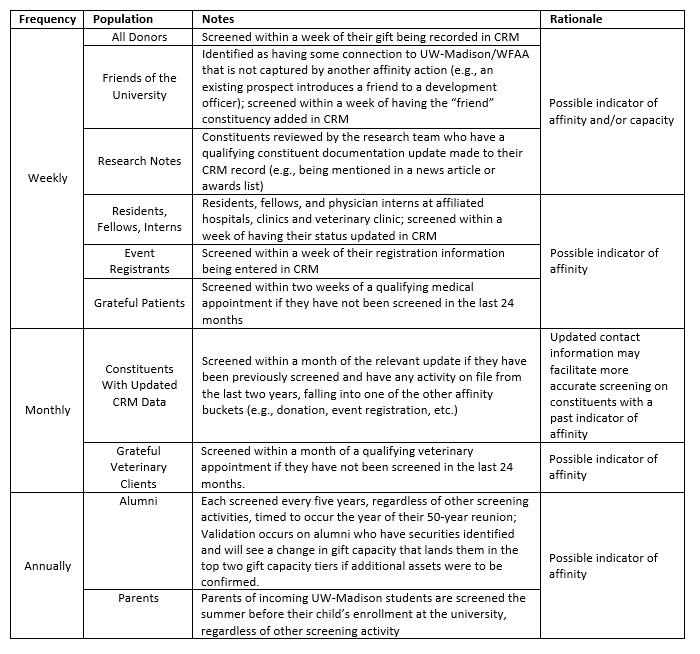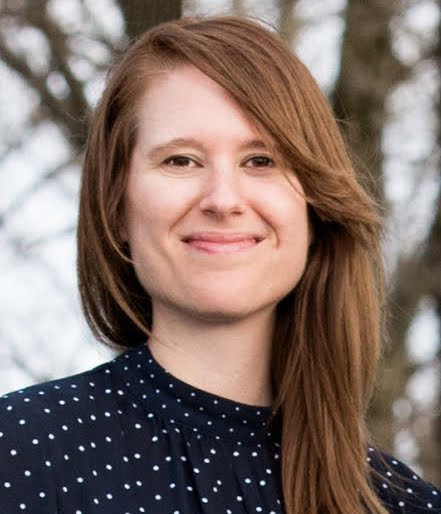
Editor's Note: This article is featured in Best of Connections 2021. Read Apra Editorial Advisory Committee Chair Jessica Balsam's editor's message to learn more about the top articles of the year.
Understanding constituent gift capacity is a fundamental component of prospect identification, prioritization, cultivation and solicitation. But when it comes to wealth screening your organization’s constituents, where can you begin? And where do you go from there?
As a tumbleweed rolls on across a majestic landscape, so does the screening process here at Wisconsin Foundation and Alumni Association (WFAA), a private, nonprofit organization that advances the objectives of the University of Wisconsin-Madison (UW-Madison). Our tumbleweed approach to screening, a work in progress since 2017, has led to enhanced capacity insights and better engagement of UW-Madison’s constituents. Here’s how we developed a method for timely, strategic screening — and lessons learned along the way.
Wealth Screening Basics
Organizations collect, analyze and utilize constituent wealth data. The data may be used alone (e.g., when sharing research findings with colleagues) or as part of a gift capacity model to estimate individual prospects’ philanthropic ability to give to an organization. Development officers, researchers and other advancement staff take a keen interest in these insights.
Wealth data collection is largely done systematically; for most organizations, that means utilizing a third-party vendor via a paid contract for a set amount of screening data over a set period (e.g., 100,000 constituents per year).
Following an automated screening, our Prospect Research team also manually validates select screening results to confirm identified wealth data. Not all constituents who are wealth screened are validated. Generally, the segments we validate include constituents who would see a change in gift capacity (compared to their previous rating) landing them in the top three gift capacity tiers if assets identified during the automated screening were to be confirmed.
The Tumbleweed Approach
With over one million constituents in our database, a routine screening of everyone in the CRM would not be feasible.
Despite their reputation, tumbleweeds in the wild do not pick up everything. But they do grow by gathering other tumbleweeds and bracken — you know, key tumbleweed stuff. We needed a process that could be selective, too — picking up only those constituents of greatest potential interest, since including every single record that our tumbleweed “rolled by” was not an option.
Our tumbleweed screening approach is a predictable, sustainable method for prioritizing the use of limited screening resources and staff time. In recent years, our focus has refined to a select array of populations within our customer relationship management system (CRM), all rising to a threshold of interest based on: 1) a connection to UW-Madison that could suggest affinity, and/or 2) a proactive constituent behavior or staff insight that could suggest affinity or capacity for constituents not previously screened.
These populations include:

Weekly, monthly and annual screenings are run in batches by the prospect development data specialist. Validations are subsequently completed by two research program specialists and one to two prospect research interns.
This approach allows us to leverage the engagement work of our colleagues in advancement and alumni relations. A salient tumbleweed population to use as an example on this point is event registrants.
Our partners on campus, alone and with foundation staff, present an array of events on diverse subjects of interest to university community members and the public — from areas of academic focus to current events and identity-based engagement. The topics tie into fundraising initiatives that may speak directly to a potential prospect’s areas of interest.
For example, let’s say the university was to offer a virtual panel discussion about COVID-19, bringing together an epidemiologist, a vaccine research scientist and an economist to talk about the trajectory of the pandemic. By working together and running the registrant data from that event through the tumbleweed process, we can identify individuals whose affinity for the university’s work coincides with the capacity to make significant financial impacts — even if the constituents haven’t (yet) asked us, “How can I support COVID-19-related efforts at UW-Madison?” By operating on a set schedule, this information enters our data universe promptly, allowing staff to utilize it while still fresh.
Watch Out for Unwieldy Tumbleweeds
Googling the phrase “out of control tumbleweeds” returns surreal sights of houses and highways buried by mountains of intrepid plants. In earlier iterations of our process, our tumbleweed wealth data queues seemed similarly overwhelmed. In addition to refining our populations, we have limited screening and validation loads further by excluding select constituents, such as individuals under age 30, previously disqualified prospects, donors engaged only in transactional giving (for a membership to access popular campus facilities and other perks) and more.
Before implementing these exclusions, validations were piling up, wealth data was aging and lower-priority validations were mixed indiscriminately with high-priority validations. Refining criteria with a focus on prioritization and feasibility made the process more strategic, volumes more manageable and translated into timely, accurate wealth data on constituents of greatest interest to the development team.
Initial Results
WFAA has analyzed initial results for the tumbleweed process to see if our methodology yields positive outcomes. Given the timelines of major gift solicitations, our results data are still preliminary but early indications are promising.
In an analysis of select tumbleweed affinity populations from a recent 15-month period, the tumbleweed affinity populations proportionally outperformed other, less-targeted screening populations by multiple key metrics: the rate at which individuals are engaged by development via a cultivation plan, number of plans with qualified and accepted asks, the value of related gift commitments and value of realized gifts (dollars in the door following commitment to give).
Our analysis also shows that tumbleweed is succeeding in another area of interest: highlighting fresh prospects in our CRM data — potential diamonds in the rough just waiting to be discovered. Fully half of all tumbleweed constituents who have been engaged on a cultivation plan since their screening was never previously identified as potential prospects or cultivated. Of newly-cultivated tumbleweed prospects who were not previously identified as potential prospects, more than three quarters had been in our CRM for over a year, and 60% were more than five years old.
Creating Your Tumbleweed Process
To distill some of the lessons coming out of WFAA’s experience, here are our top tips for an institution looking to implement a similar process:
- Inventory your resources: Review the terms of screening contracts, including the number of screenings you are allowed to perform, and staff availability.
- Consider restrictions: These include data integrity requirements, legal regulations related to HIPAA or political giving and existing cultivation practices.
- Evaluate your institution’s unique data landscape: Look for indicators of constituent affinity and capacity in your CRM.
- Evaluate the bigger picture: Run forecasts from past data and look for opportunities to limit volume.
- Start small: Test your new procedures on just one or two populations at first.
- Analyze: Monitor the process (e.g., volume, feasibility) and the results (e.g., tag constituents so you can follow them over time). Adjust as needed.
Roll On
We hope you can draw inspiration from our journey so far. Our team looks forward to evaluating future results and innovating to further improve the process. May it roll on.
WFAA is a private, nonprofit organization that advances the objectives of the University of Wisconsin–Madison by encouraging the interest, engagement and financial support of alumni, donors and friends in the life of the University and with each other. Their 18-member Research and Prospect Management team supports over 80 development staff members.
 |
Viv Chappell is the prospect research manager at WFAA and has previously served in other positions in fund development, prospect research and prospect development. She currently manages a team of eight researchers. |
 |
Kelley Rowe is the prospect development data specialist at WFAA. Her previous experience includes data management and integration and process development in the nonprofit arts industry, before joining WFAA.
|

Viv Chappell
Prospect Research Manager, WFAA
Viv Chappell is the prospect research manager at WFAA and has previously served in other positions in fund development, prospect research and prospect development. She currently manages a team of eight researchers.
Kelley Rowe
Prospect Development Data Specialist, WFAA
Kelley Rowe is the prospect development data specialist at WFAA. Her previous experience includes data management and integration and process development in the nonprofit arts industry, before joining WFAA.